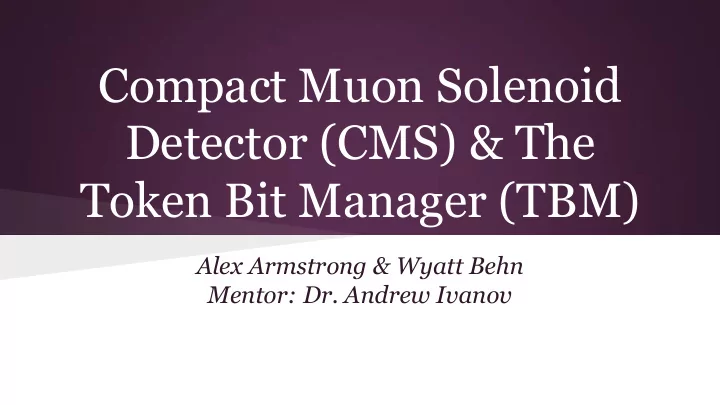

Compact Muon Solenoid Detector (CMS) & The Token Bit Manager (TBM) Alex Armstrong & Wyatt Behn Mentor: Dr. Andrew Ivanov
CERN Conseil Européen pour la Recherche Nucléaire (European Council for Nuclear Research) (1952)
CERN -> LHC Large Hadron Collider (2008) 1) ATLAS Two proton beams 2) ALICE travel in opposite 3) LHCb directions until 4) CMS collision in detectors
CERN -> LHC -> CMS Compact Muon Solenoid (2008)
CMS Detector System
Inner Detectors Silicon strip detectors in the inner tracking system detect position of particles at a given time
CMS Detector System
Electromagnetic Calorimeter (ECAL) Lead tungstate crystals formed into supermodules measure energy of electrons and photons
CMS Detector System
Hadron Calorimeter Repeated layers of absorber plates (brass and steel) and active scintillating material detect neutral and charged hadrons
CMS Detector System
Muon Chambers 4 layers of muon detection stations interspersed with iron “return yoke” plates detect muons
CMS Detector System
Inner Tracking System ● Consists of 3 barrels of pixel detectors that amounts to a 4.4-10.2 cm radius tube TBM ROCs ● [This picture displays a TBM connected to 16 ROC (read out chips)]
More Inner Tracking ● The Inner Tracking Detector has 66 million pixels ● The whole system is cooled to -20 0 C ● Each silicon sensor is only 150 x 100 μm (about 2 hair widths)
Problems
Problems 1) SO MUCH DATA! - 40 terabytes/second a. Level 1 Trigger System - L1T (3500ns latency) b. Higher level trigger - HLT 2) High Collision Rate - 40 MHz (25ns gap) a. Buffer zones in ROCs and high time resolution
Level 1 Trigger ● Completely Automatic - No Software ● Selects ~1/10,000 hits ● The whole system is the trigger 1) Detection by Calorimeter and Muon Chambers 2) Hardware analysis selects desirable events 3) Acceptance/rejection message sent to TBM 4) TBM sends message to ROC to collect or discard 5) Collected messages are sent downstream
What We’re Doing/Specifics ● Presently, working on understanding the code used for testing the TBM chips (VC++) ● Using Cascade software for controlling the testing station ● Understanding how the TBM interacts and functions as part of the detector system
The Testing Software/Code Interface Header GUI Headers Reference Library for Code
Hardware & Calibration ● Using Cascade Probe Station and Nucleus 3.2 Interactive Software ● The stage (or chuck) moves freely beneath a stationary testing board that contains a probing zone ● The wafer is placed on the chuck and raised up to the board to make a connection and run tests (Note: Only 50 μm of freeplay are allowed when making connection) ● Some issues with the chuck being unbalanced could lead to crashing the probe
The Probing Station The test board floats above a free moving stage. The microscope is placed above for navigation.
Current Group Problem Unstable electronic connection between TBM chip and probe
Our Endgame ● Have a fully automated way of testing each wafer, and each unique version of TBM chip, with an automatic data output (pass/fail) identifying individual TBMs ● Alternatively, an efficient way to test all TBMs on each wafer so we at least know if they work as designed
Why CMS is Important ● CMS is one of the proposals for a more powerful detector at the Large Hadron Collider (LHC) ● It will be able to handle higher-energy collisions (greater luminosity) with more accuracy and be able to reduce the data stream to a manageable load
Wyatt’s Quandaries ● How do the calorimeters and other detectors work in tandem with the TBM to reduce the data? ● Theoretically, what are we interested in seeing? More particles, or reinforcement? More about the particles and interactions in question. ● Using ROOT to analyze actual data/making pretty graphs.
Alex’s Goals of Understanding - The testing code - TBM Chip design - ROOT - Top Quark Research
Recommend
More recommend